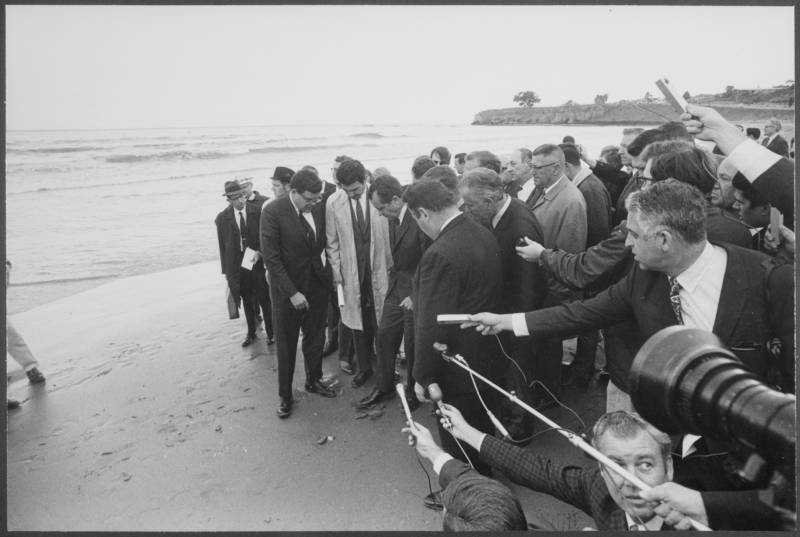In April, Interior Secretary David Bernhardt said the Trump administration was putting on hold its plans to open up more coastal waters to oil and gas drilling, including off the coast of California. The decision follows a defeat in federal court and lots of pushback from coastal states, some of which supported Trump in 2016.
California and Offshore Drilling: Like Oil and Water

It’s been 35 years since new federal leases for drilling along the Pacific coast have been issued. Polls show that a vast majority of Californians and most Americans oppose offshore drilling. But while the practice is banned in state waters, without federal legislation the possibility for renewed production more than 3 miles from shore still remains.
Richard Charter is a longtime ocean protection advocate. He talked with KQED’s Brian Watt about the Trump administration’s efforts to upend longstanding policy on the issue.
The following excerpts have been edited for length and clarity.
What are the risks from offshore drilling?
The risks begin with the initial drilling, because there are routine discharges into the ocean that just happen day to day from normal operations. So you don’t need to have an accident to have toxics going into your near-shore coastal waters.
But the big risk, of course, and sort of the poster child for the worst-case scenario, was the Deepwater Horizon accident in the Gulf of Mexico, which of course was many orders of magnitude greater than the Santa Barbara blowout in 1969. If you release oil that is under pressure, under the seabed, into the ocean in an uncontrolled fashion, and you can’t shut it off, it can continue for months or years. A scenario like Deepwater Horizon that happens off the coast of California would wipe out your commercial fishing industry and your coastal-dependent tourism industry.
Can Trump get this done in California, amid so much opposition?
Well I stopped making predictions about this when Donald Trump became president. One of his first acts in January 2018 was to announce he was opening about 90% of the U.S. coastline to offshore drilling, and most of that had been long protected under bipartisan congressional moratoria that was renewed year after year for 27 years.
So it was disconcerting to say the least when a week after that announcement, his secretary of Interior, Ryan Zinke, walked out at the Tallahassee airport with Gov. Rick Scott and said that Florida was off the table (for drilling). And that triggered about 16 different governors up and down the Atlantic and Pacific coasts of both parties saying, “We want out, too” — accompanied by about a dozen attorneys general from various states who filed suit.
What’s the most common argument for drilling offshore in light of the accidents that have occurred?
Well of course the first thing we always hear from the industry is, “Don’t worry, be happy. We will not have another accident.” And that’s usually shortly before they have another accident. And I think the determining factor for this particular decade was the Deepwater Horizon incident, which obviously was not only an environmental tragedy but a human tragedy in that workers died unnecessarily on that rig mostly because of negligence on the part of the operators.
How much can California really do to thwart drilling in federal waters?
It can find that the offshore drilling activity or some follow-on process like building the platform, building a terminal for tankers or barges, or building a pipeline is inconsistent with the state’s federally approved coastal zone management plan. In California, that would start with the California Coastal Commission, which is the oversight agency for that. During the 1980s, the state of California, the attorney general, and many local governments took then-Interior Secretary James Watt to the U.S. Supreme Court on that.
The other thing a state can do is ban offshore drilling in its own state waters, which California did many years ago. Last year, California upped the ante by banning infrastructure to support federal offshore drilling anywhere in state waters, from the shoreline to three miles out. In doing that, you’re saying if you do lease, President Trump, off the coast of California, you’re not going to be able to bring it ashore. And that serves as an economic disincentive to the companies to even bid. It’s kind of the porcupine strategy of don’t mess with us. But it’s not a sure thing.
Really the litigation is what has derailed Trump’s plan for now. But a lot of people don’t realize Southern California leasing under the Trump plan was going to begin next year in 2020. And Central California and Northern California in 2021, so this is something that’s coming very fast.
Until David Bernhardt actually removes the five-year program from consideration, we’re not assuming it’s something we can trust.
There have been two developments since we spoke with Richard Charter. On Thursday, California Sen. Dianne Feinstein introduced legislation to “permanently ban offshore drilling in federal waters off the coast of California, Oregon and Washington.” The bill is likely to face stiff opposition in the GOP-controlled Senate. Rep. Jared Huffman (D-San Rafael) is sponsoring a companion bill in the House.
On the same day, citing “unnecessary regulatory burdens,” the Trump administration significantly rewrote safety rules for offshore drilling put in place after the disastrous Deepwater Horizon spill in the Gulf of Mexico in 2010.
